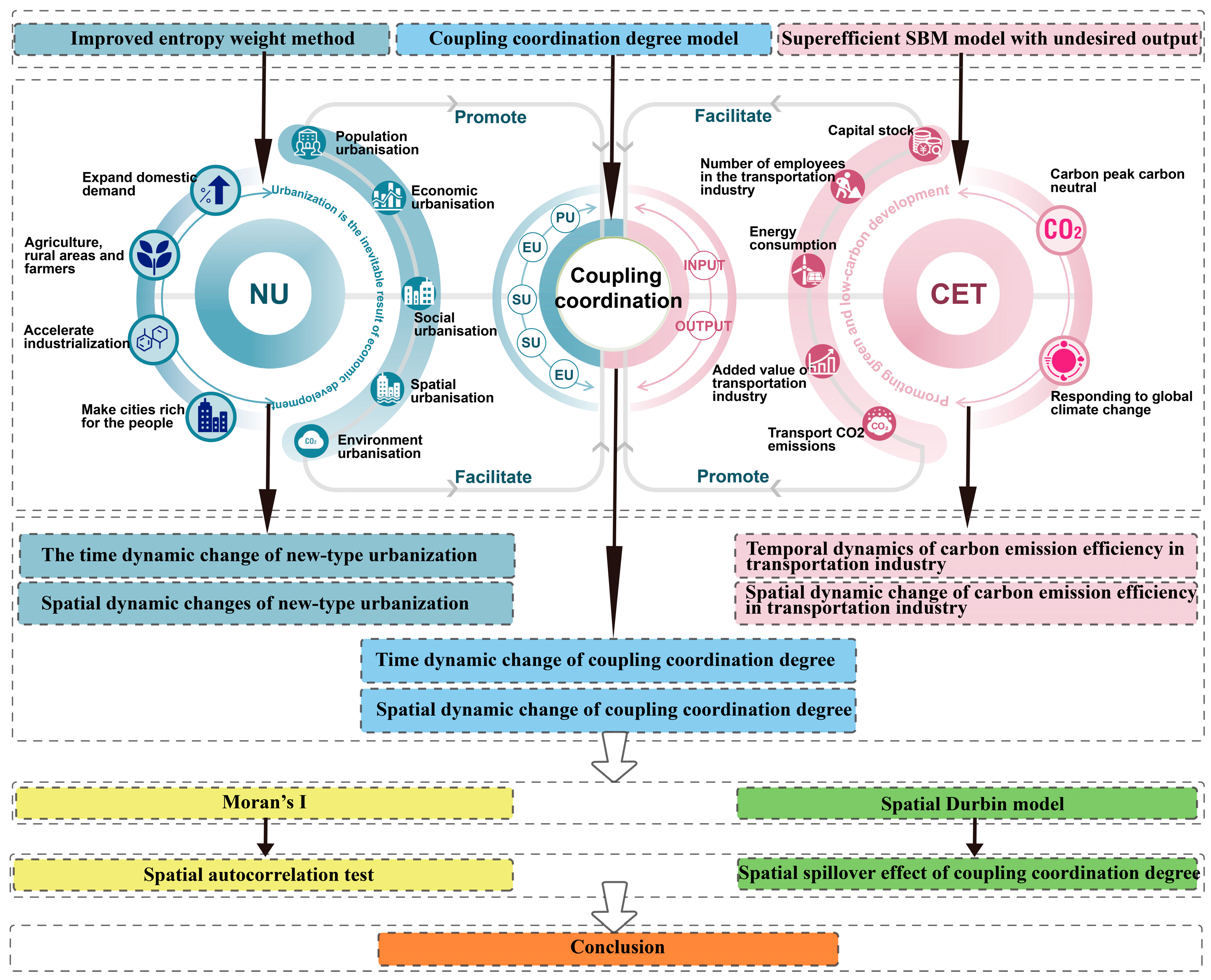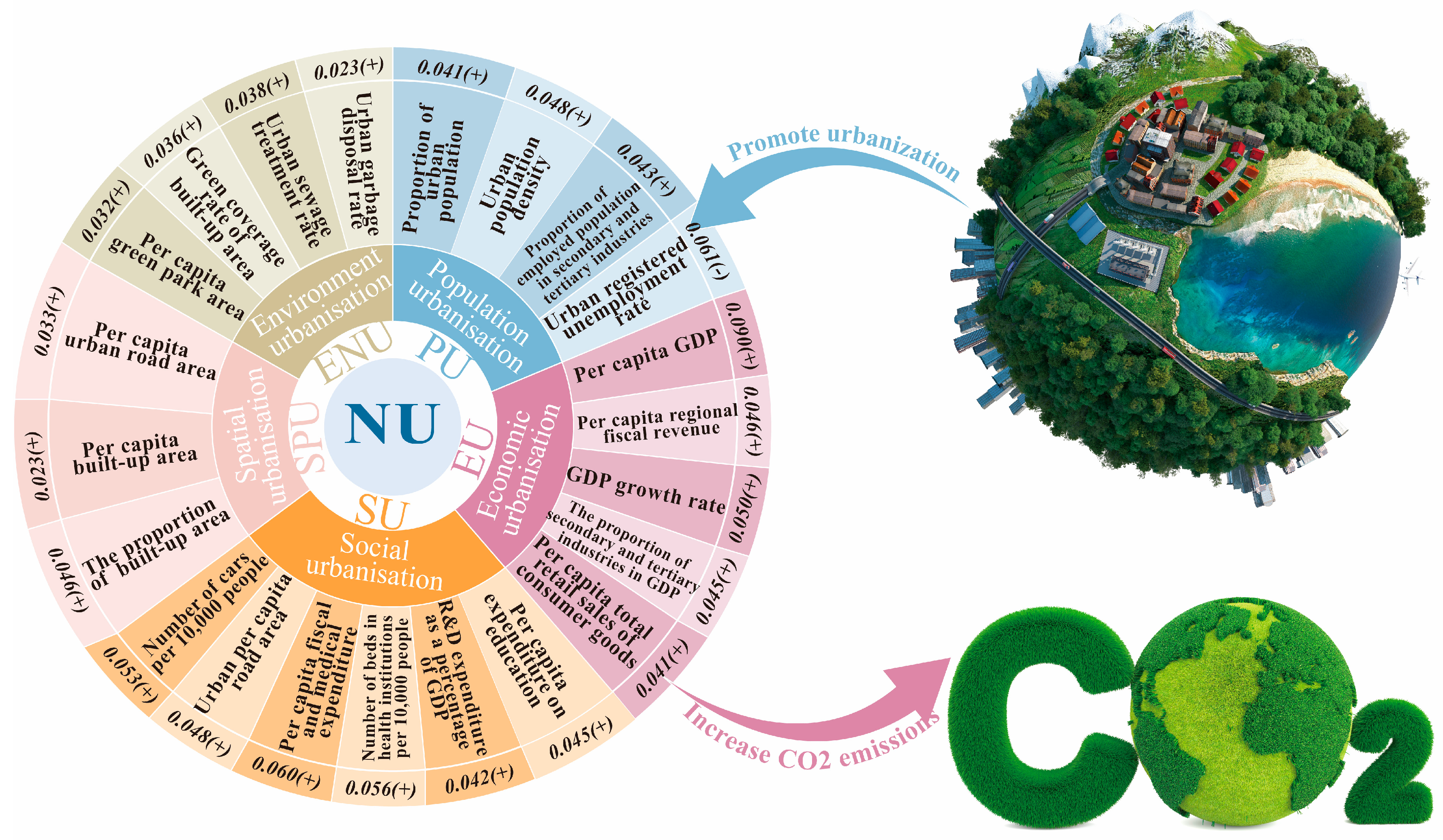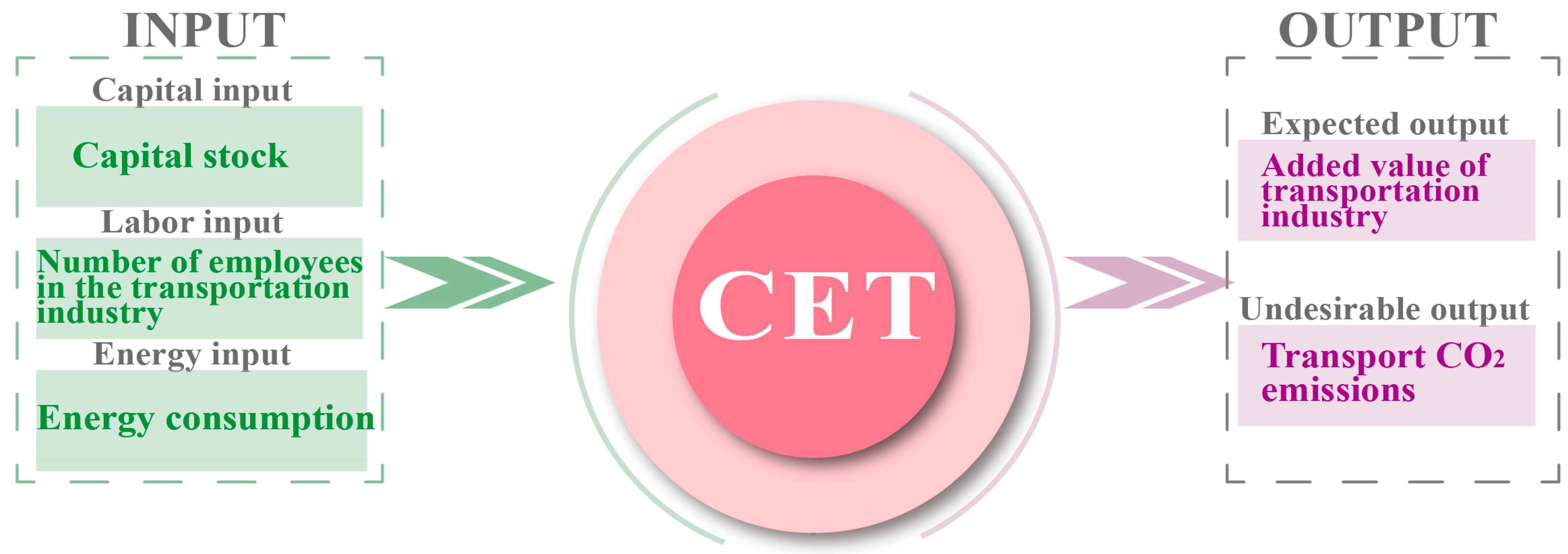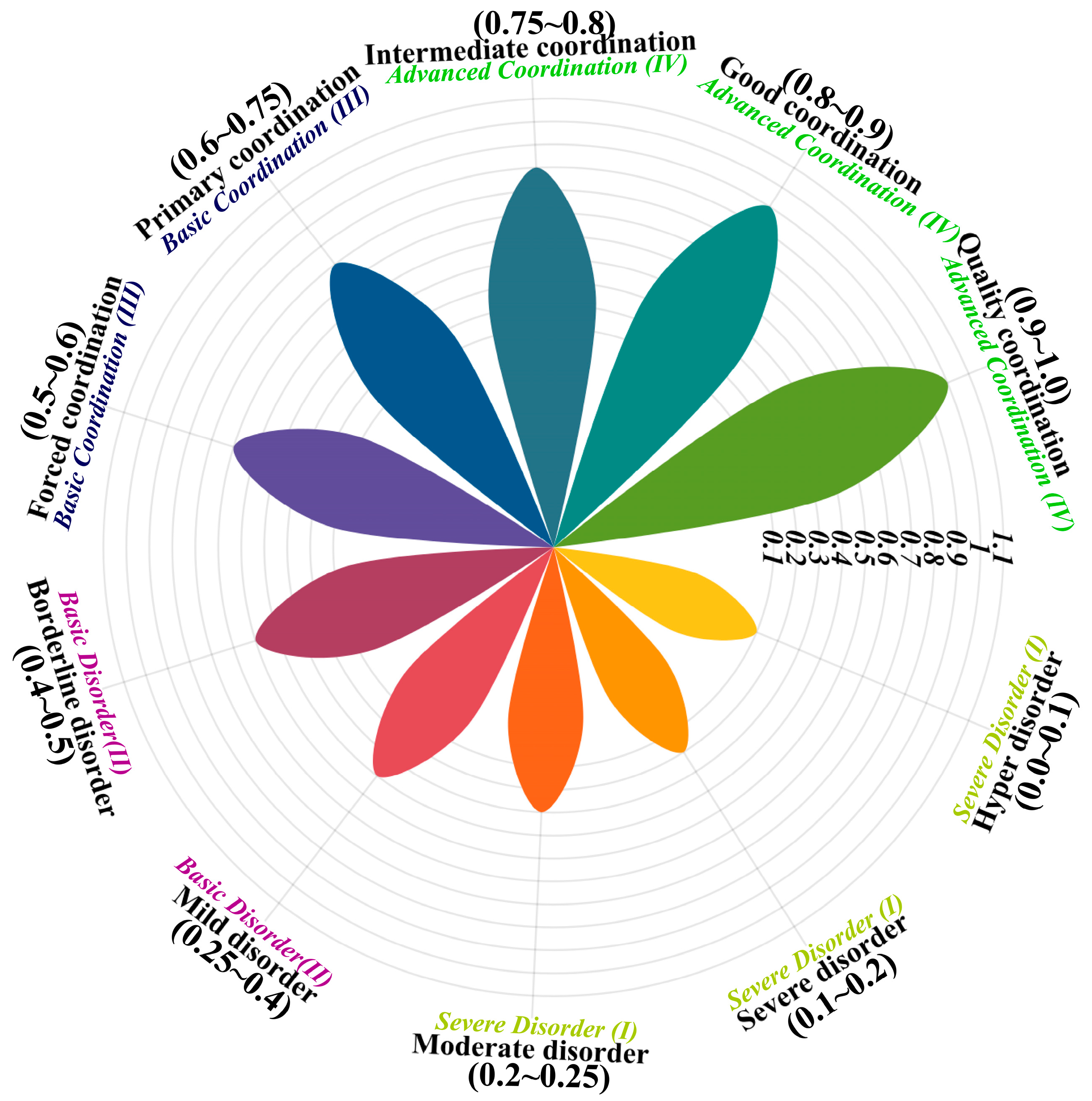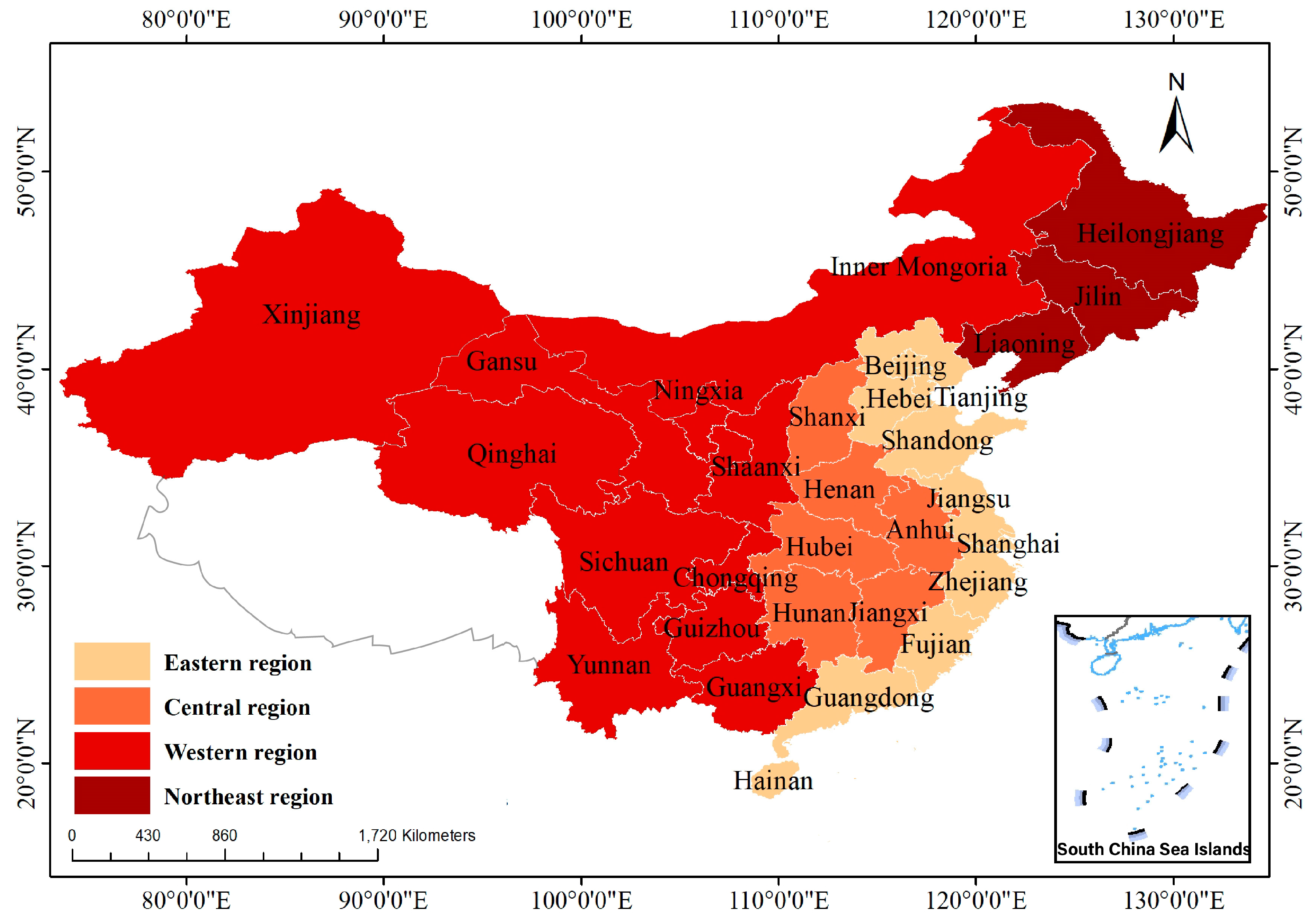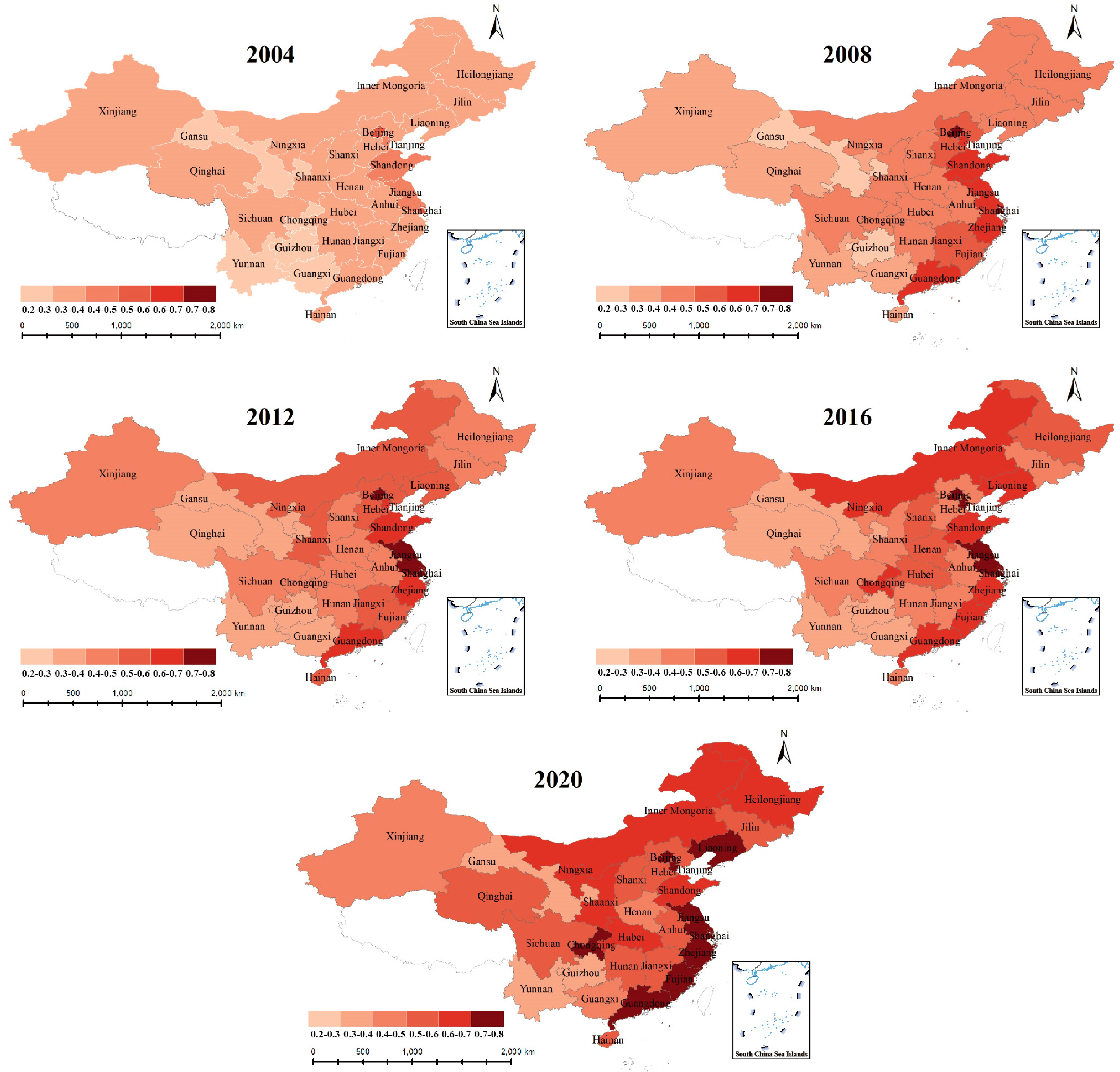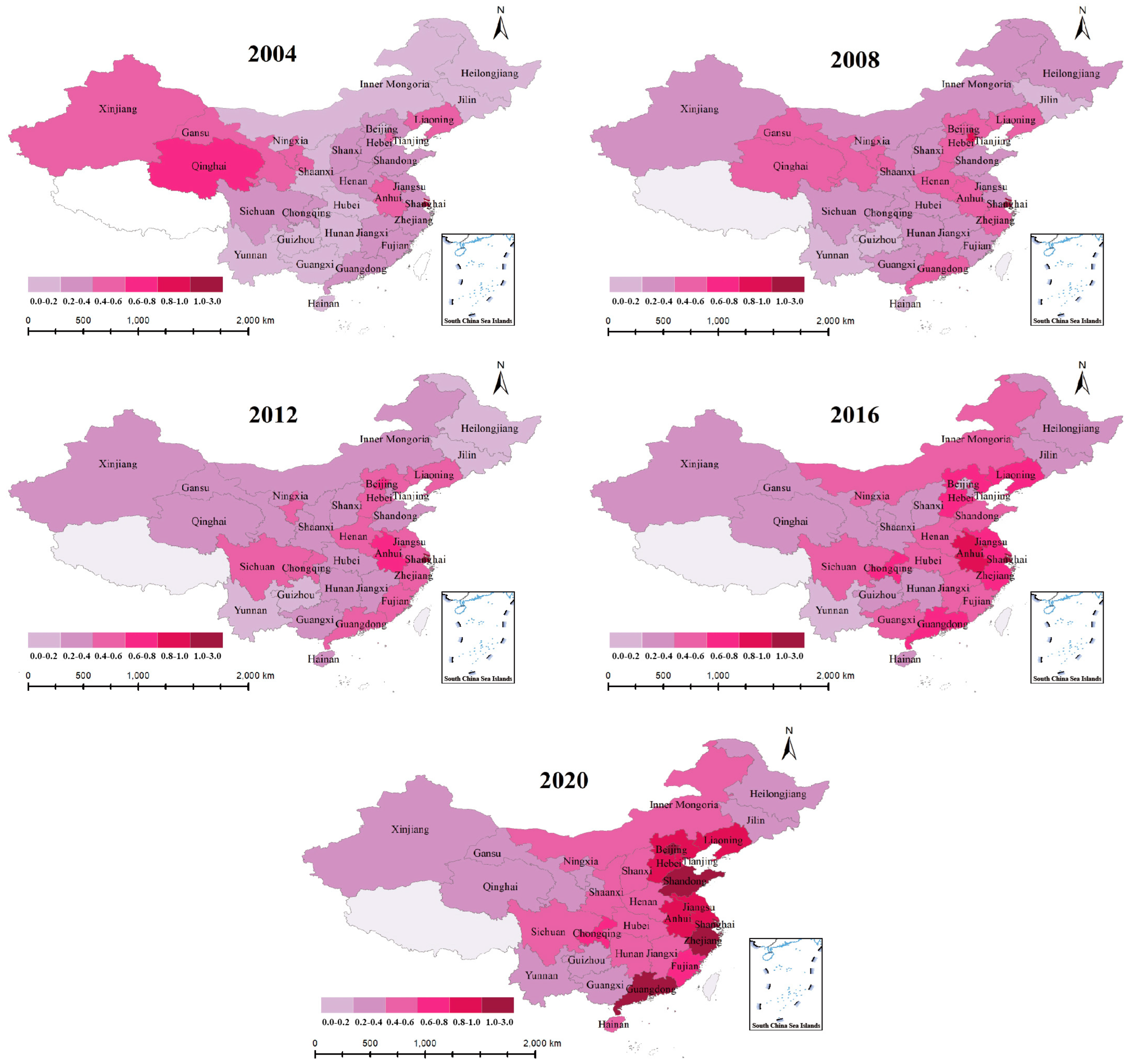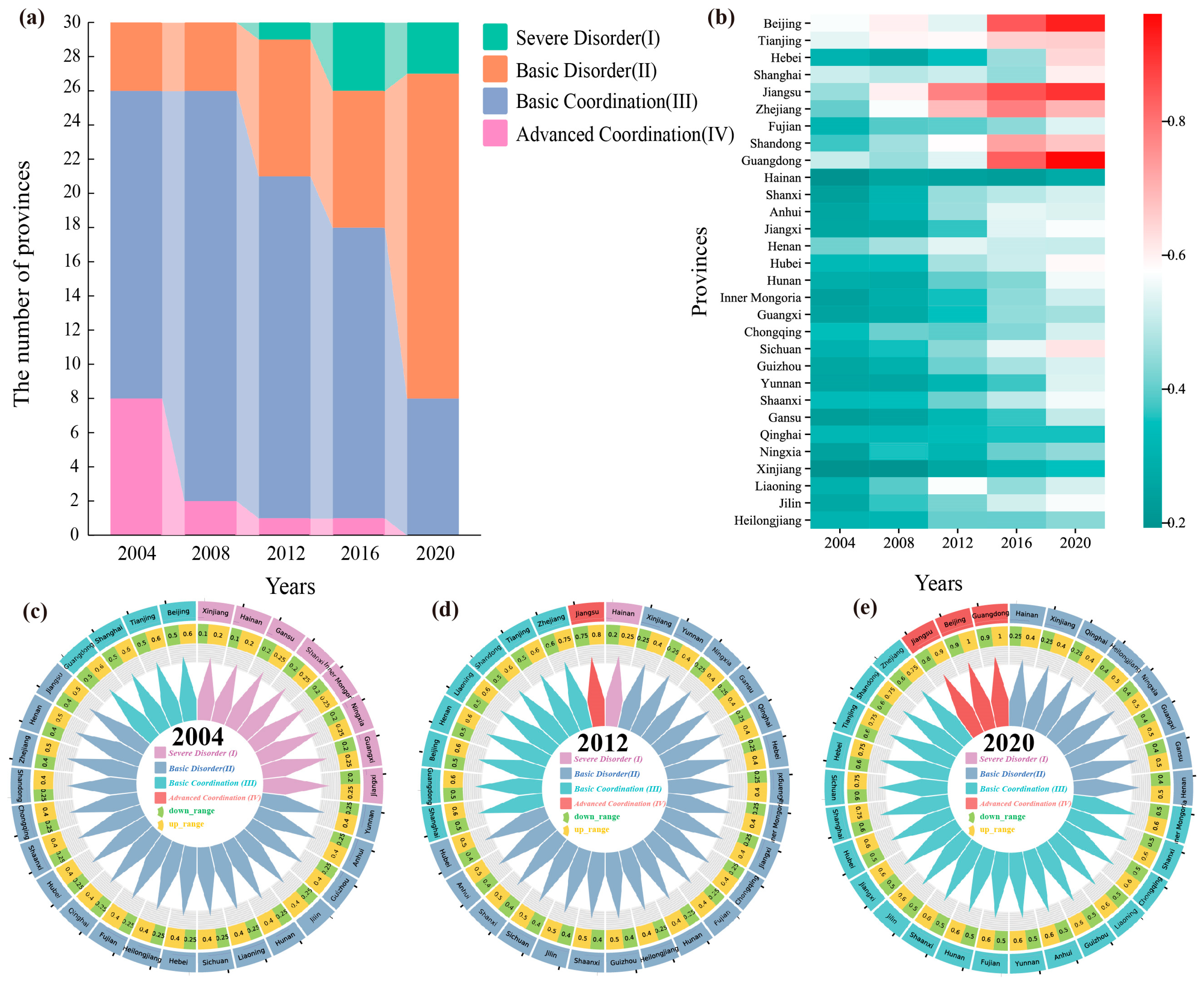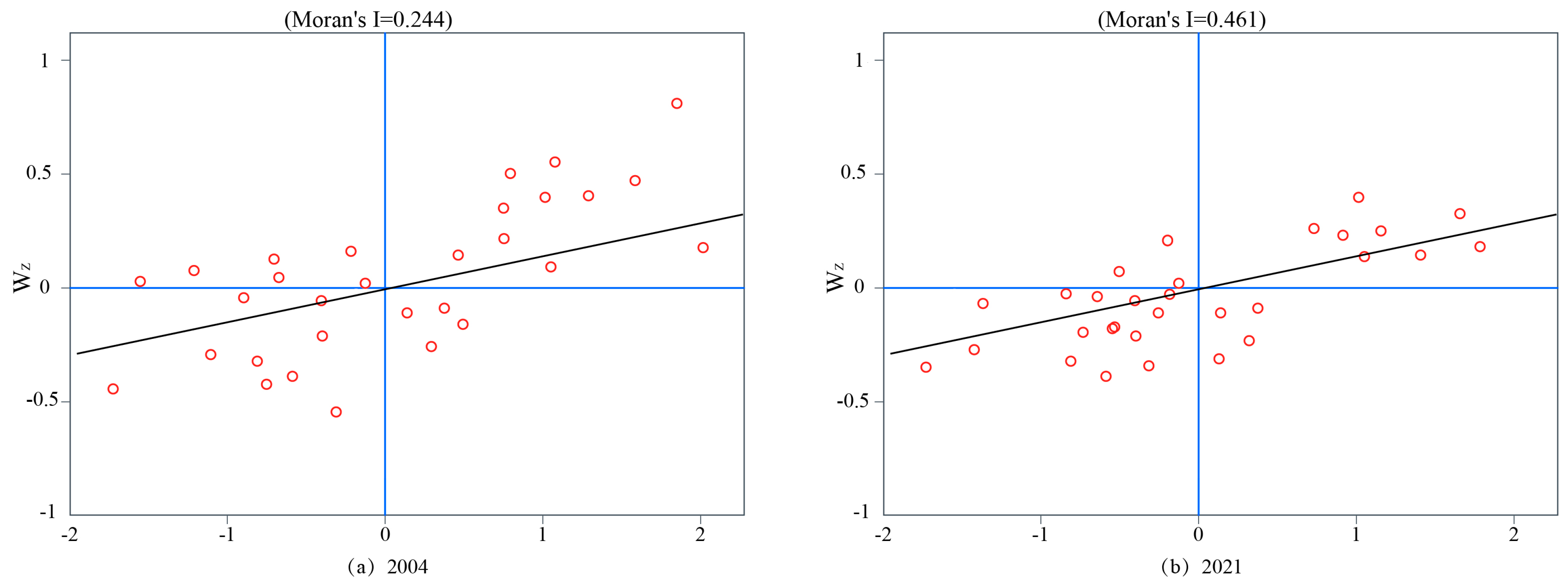1. Introduction
Against the backdrop of the urgent global response to climate change, green and low-carbon transformation has become a core issue for countries to realize sustainable development [
1]. As the world’s largest carbon emitter, China’s “carbon peak” and “carbon neutral” goals (hereinafter referred to as the “dual carbon” goals) are not only the top-level design of the national strategy [
2,
3], but also a systematic challenge to economic structural transformation and regional synergistic development [
4]. The realization of this goal depends on the synergistic promotion of many fields, among which the coupling and coordination of new-type urbanization (NU) and transportation carbon emission efficiency (CET) is especially crucial. NU emphasizes the transition from “land expansion” to “human-centered, intensive, green and low-carbon” mode, focusing on urban–rural integration, industrial upgrading and ecological protection [
5]. As the second largest source of carbon emissions in the world [
6], the improvement of the efficiency of the transportation sector is directly related to the national carbon emission reduction process. At the same time, the rapid development of the digital economy (DE) is reshaping traditional production methods and enhancing the formation of new productive forces. DE, characterized by digital technology penetration, data-driven innovation, and platform-based business models, can significantly accelerate the green transition by optimizing resource allocation and promoting energy efficiency. For instance, emerging digital technologies such as big data, artificial intelligence (AI), and Internet of Things (IoT) can effectively monitor urban traffic flows in real-time, improve transportation demand management, and facilitate smart transportation systems, thereby directly boosting CET. Moreover, the integration of DE into NU facilitates industrial digital transformation and upgrading, encourages cleaner production, and enhances regional innovation capability, further strengthening the coupling between NU and CET. However, the spatial distribution imbalance and uneven technology diffusion of DE might exacerbate existing regional gaps, presenting both opportunities and challenges for synergistic regional development [
7]. Thus, exploring the interactive mechanisms among DE, NU, and CET becomes increasingly vital for achieving China’s dual-carbon targets. However, during China’s rapid urbanization and transportation expansion, problems such as regional development imbalance, technology penetration differences and insufficient policy synergy have become increasingly prominent [
8]. As a result, the efficiency of carbon emissions shows a spatial differentiation pattern of “high in the east and low in the west” [
9]. In this context, revealing the interaction mechanism between NU and CET and their spatial and temporal evolution patterns has become an important breakthrough in solving the bottleneck of the “dual-carbon” target [
10].
The coupled and coordinated relationship between NU and CET is the key to realizing the green low-carbon transition and the “dual-carbon” goal [
11,
12]. Scholars have analyzed the interaction mechanism between the two from different perspectives, but there are significant differences in views, mainly reflected in the following three aspects: 1. NU is the driving force to enhance CET. Based on the perspective of economies of scale and technological innovation, some scholars believe that NU can promote CET enhancement through industrial structure optimization, intensive resource utilization and technology diffusion [
13,
14]. For example, Bornemann [
15] points out that population agglomeration and industrial agglomeration in the process of NU can reduce the energy consumption per unit of transportation and enhance the overall transportation efficiency through shared transportation infrastructure (e.g., rail transportation network). Recent empirical studies demonstrate that digital twin-enabled smart logistics systems can further reduce energy consumption per unit transportation by 18–25% through real-time demand forecasting. In addition, technological spillovers within urban agglomerations (e.g., the promotion of new energy technologies) can accelerate the low-carbon transport transition [
16]. Zhao [
17] further suggests that NU-driven equalization of public services (e.g., intelligent transportation systems) can optimize the travel structure and reduce private car dependence, thereby reducing carbon emission intensity. This school of thought emphasizes that the synergistic effect of NU and CET has been initially seen in developed regions in the east, and that the core mechanism lies in the positive cycle of “agglomeration-efficiency-emission reduction” [
18]. 2. Inhibitory effect of crude NU on CET. Another group of scholars focuses on the pressure of NU expansion on the resource environment, arguing that rough development without planning may exacerbate the degradation of carbon emission efficiency [
19]. AlMulali [
20] found in the central and western regions with lagging infrastructure the mismatch between the expansion of the transportation network and the surge in energy demand leads to the “high growth—high emission” dilemma. In addition, Zhu [
21] points out that “passive NU” (i.e., population inflow lagging behind land development) in the central and western regions leads to fragmentation of transportation demand, exacerbating reliance on traditional fuel vehicles and further widening the regional CET gap. 3. The synergistic relationship has nonlinear characteristics. Some studies introduced the theory of Environmental Kuznets Curve (EKC) and proposed that the synergistic relationship between NU and carbon emission rate has nonlinear characteristics and critical thresholds [
22,
23,
24]. Zhang [
25] found, based on Chinese provincial data, that when the NU rate is lower than 60%, the effect of NU on CET is dominated by an inhibitory effect. And beyond this threshold, the superimposed effect of technological innovation and policy regulation turns the elasticity coefficient positive. This finding is consistent with Wang’s [
26] “U-curve” hypothesis. That is, the infrastructure construction and energy demand surge at the early stage of NU will lead to a decline in carbon emission rate, but with the maturity of green technology and the improvement of the system, the synergistic effect will gradually appear. However, a follow-up study by Wang [
27] emphasizes that the attainment of this threshold is highly dependent on regional endowments: in the eastern region, the threshold is about 55% due to stronger technological reserves and policy implementation, while in the central and western regions, the threshold may be as high as 70% due to the constraints of industrial structure and financial capacity, and the path of attaining the target is more tortuous.
Studies in recent years have also begun to focus on the spatial dependence of the synergistic relationship between NU and CET. Zhang [
28] used the spatial Durbin model (SDM) to find that low-carbon transportation technologies (e.g., the popularization of electric vehicles) in the eastern provinces can lead to the enhancement of carbon emission rates in neighboring provinces through industry chain linkages and knowledge spillovers. However, this positive effect may be offset by the transfer of high-carbon industries from the central and western regions. These differences suggest that it is difficult for a single regional policy to achieve synergistic development on a national scale. Low-carbon synergistic transformation between regions must be promoted through cross-regional policy coordination and technology sharing [
23]. Yang [
29] further proposed the “center-edge” theory. It is argued that the NU process of core city clusters (e.g., Beijing-Tianjin-Hebei, Yangtze River Delta) can form regional low-carbon corridors through transportation integration and carbon trading market construction. On the other hand, due to the lack of policy synergy and technological segregation, the peripheral regions can hardly enjoy the spillover dividends and even increase the pressure on local emissions by taking over high-carbon industries. Notably, the national “East Data West Computing” project has established cross-regional digital synergy mechanisms, where western data centers utilizing eastern-developed AI energy-saving algorithms reduced PUE values by 0.15–0.3, mitigating 22–35% of carbon leakage effects. This theoretical framework provides an important basis for this study to reveal the spatial differentiation pattern of “East High, West Low”.
Traditional studies have mostly focused on economic or demographic dimensions, with less integrated consideration of social, spatial and environmental factors, neglecting the moderating role of social equity and ecological resilience on NU-CET synergy. The urbanization evaluation system proposed by Xu [
30] measures the level of urbanization mainly through economic indicators such as urbanization rate and GDP growth rate. This framework effectively captures the direct impact of economic growth but lacks consideration of social inclusion and ecological environment. Jiang [
31], on the other hand, focused on analyzing the impact of urbanization on carbon emissions. Despite focusing on the environmental effects of urbanization, the synergistic effects of economy, social structure and spatial layout on carbon emission efficiency were not explored in depth. In addition, Chen [
32] analyzed the social effects of urbanization through social dimensions such as population mobility and per capita income in their study. However, it failed to incorporate industrial structure, green and low-carbon development and other factors, which led to a certain one-sidedness in its evaluation system. Similarly, Luo’s [
33] study, although considering regional differences, mainly analyzed from the perspectives of land use and economic growth, and failed to fully reveal the relationship between NU and long-term goals such as regional balance and ecological restoration.
In contrast, the urbanization indicator system proposed in this paper breaks through the one-dimensional limitation of existing studies and combines five core areas: population urbanization, economic urbanization, social urbanization, spatial urbanization and environmental urbanization. Each area involves multiple dimensions and key indicators, comprehensively reflecting the multidimensional effects of NU. For example, the four indicators of population urbanization (PU) are able to capture population mobility and social inclusion more precisely [
34]. The five indicators of economic urbanization (EU) systematically measure the changes in economic structure and the effects of industrial transformation in the process of urbanization [
35,
36]. The six indicators of social urbanization (SU) assess the impact of urbanization on social welfare, health, education and innovation capacity from a broader perspective [
37]. The three indicators of spatial urbanization (SPU) reflect the sustainability of infrastructure development and spatial expansion [
38]. Finally, the four indicators of environmental urbanization (ENU) comprehensively examine the ecological environmental protection and resource use efficiency in the urbanization process [
39]. Compared with existing studies, the innovation of this paper is that it not only integrates a multi-dimensional indicator system of economic, demographic, social, spatial, and environmental dimensions, but also emphasizes the interaction and coordination among these dimensions. Therefore, the urbanization evaluation system proposed in this paper provides not only a more systematic framework for theoretical research, but also a more precise and actionable guide for regional policy design in practice through a comprehensive multi-dimensional analysis.
Most of the existing studies have explored the relationship between NU and CET [
40,
41]. However, static models are commonly used for analysis, failing to effectively capture the dynamic process of spatio-temporal evolution and inter-regional variability. To some extent, this approach ignores the complex spatio-temporal interactions between NU and CET and fails to reveal the specific differences and challenges in different regions and time periods. In contrast, this study introduces spatio-temporal data and spatial effects by combining spatio-temporal evolution and spatial spillover effects, using the coupled coordination degree model (CCDM) and spatial Durbin model (SDM) [
36,
42]. The interaction between NU and CET is systematically analyzed from a dynamic perspective. We not only focus on the data changes in different years but also analyze the regional differences among provinces at the spatial level, especially the different challenges and opportunities faced by the eastern and central-western regions in the process of NU.
Compared with previous studies, this paper demonstrates significant innovative points and marginal contributions in exploring the coupled coordination relationship between NU and CET. (1) In the context of the important policy orientation of emission peak and carbon neutrality, we examine the impacts of China’s current stage of NU and CET and verify the two-way synergistic relationship between the NU and CET. On the one hand, NU has a supportive driving effect on CET; on the other hand, CET has a feedback push on NU, which enriches the research results on the NU and CET. (2) Past studies have tended to look at only a single dimension when assessing NU and CET. However, this paper adopts a more comprehensive and systematic analytical framework within the policy. Specifically, we comprehensively assess NU from five dimensions: demographic, economic, social, spatial, and ecological. Meanwhile, we comprehensively assess CET from three input dimensions: labor, capital, and energy, as well as two output dimensions. Through this multidimensional analysis, we systematically reveal the current status of NU and CET in China at this stage. This not only helps the government to more accurately grasp the current development characteristics but also provides strong data support and decision-making basis for future policy formulation and strategic planning. Ensuring that China moves steadily forward on the path of pursuing sustainable development. (3) From the perspective of coupled and coordinated development, the analysis focuses on the interaction and conduction pathways of NU and CET. Through systematic study, we draw useful conclusions. These conclusions help to further deepen the comprehensive understanding of the developmental issues of NU and CET. Our analysis not only reveals the intrinsic links between the two, but also clarifies the specific ways and pathways through which they interact, providing an important reference for future policy formulation and strategic planning. (4) This paper starts from the spatial spillover perspective of coupled coordination. It deeply explores the spatial spillover effects of per capita income level, scientific and technological innovation, labor force structure, transportation and energy intensity, industrial structure, and the degree of government intervention on the degree of coupled coordination of NU and CET. Through this study, we draw conclusions with practical guidance. These findings enable the government to more precisely identify the key wants that affect the coupled and coordinated development. Thus, a solid foundation is laid for promoting high-quality development in NU. By considering the spatial spillover effect, we provide a more comprehensive and in-depth reference basis for the government to formulate relevant policies. It helps to realize the coordinated progress of NU and CET.
The structure of the subsequent sections in this paper is outlined as follows:
Section 2: Methodology and Data Foundation. In this section, we will elaborate on the index system used, along with the research methods and models employed. This will provide a comprehensive overview of the analytical framework and data sources utilized in the study.
Section 3: Analysis of Results and Discussion. This section will primarily focus on the temporal and spatial variations observed in the NU, CET, and their coupling coordination degree. Additionally, we will conduct a spatial autocorrelation test to examine the clustering patterns and spatial spillover effects of these factors. The findings will be discussed in detail to provide insights into the complex interactions and dynamics between NU and CET.
Section 4: Conclusion and Policy Recommendations. Here, we will summarize the key conclusions drawn from the analysis and offer policy recommendations based on our findings. The aim is to provide valuable insights for policymakers to consider in their efforts to promote high-quality NU while also addressing the challenges of CET.
4. Conclusions and Future Works
4.1. Conclusions
This study reveals critical spatio-temporal disparities and mechanistic insights into the coupling coordination between China’s NU (NU) and transportation carbon emission efficiency (CET). Key findings and their implications are summarized as follows:
Analysis of regional differences and evolutionary trends: The spatial pattern of NU (NU) and carbon emission efficiency (CET) of transport shows a persistent and significant “east is stronger and west is weaker”. The formation of this pattern is deeply influenced by multiple factors, such as uneven distribution of resources, differences in infrastructure development, and different policy implementation strengths. Specifically, eastern coastal provinces such as Guangdong and Zhejiang have made significant progress in CET, with growth rates as high as 44% and 27%, respectively, demonstrating strong development momentum. However, in western regions, such as Gansu and Ningxia, the CET level has hovered below 0.4 for a long time, and the development is relatively lagging behind. From the perspective of time evolution trajectory, the development of NU and CET follows the law of “slow-fast-stable”. At the initial stage, the pace of development was relatively slow due to various constraints; then, with the promotion of policies and optimization of resource allocation, the pace of development accelerated significantly; finally, it entered a relatively stable growth stage. However, despite the positive overall development trend, the gap between regions has widened further due to structural problems in the western and northeastern regions. These regions often face challenges such as outdated industrial frameworks and serious brain drain, making it difficult for them to keep pace with the eastern regions in the development of NU and CET.
Coupling Coordination Dynamics: While coordination levels improved from “basic disorder” to “basic coordination” (2004–2021), advanced coordination remains elusive. Provinces like Beijing and Guangdong reached Level IV coordination by 2021, but Xinjiang and Inner Mongolia stagnated at Level III, constrained by fragmented transportation networks and low-tech industrial systems.
Spatial Spillover Mechanisms: TEI, IS, and STI significantly enhanced coordination, contributing 0.048, 0.491, and 0.050 to total effects, respectively. Conversely, INC and GOV exhibited limited spatial spillover, highlighting inefficiencies in cross-regional policy synergy.
4.2. Policy Recommendations
After conducting an in-depth analysis, it has been observed that the combined progress of NU and CET holds significant importance for China’s sustainable growth. In order to further enhance this synergy and ensure that development is comprehensive, enduring and resilient, this report makes the following recommendations:
(1) In order to promote the synergistic enhancement of NU and CET, the government should strengthen the coordinated development strategy between regions and optimize the policy orientation and incentive mechanism. Given the significant inter-provincial differences, the government needs to take into account the actual situation and development needs of each region. In particular, it should increase support for relatively backward regions such as the west. Specific measures include the following: a. Establish a regional coordinated development fund through the establishment of special funds, and support the infrastructure construction, industrial development and talent introduction in western and other relatively backward regions, so as to narrow the development gap between regions. b. Promote inter-regional cooperation and exchanges: Encourage industrial cooperation, technical exchanges and talent training among different regions, and attain optimal allocation and effective utilization of resources, technologies, and talents. c. Establishment of a regional coordinated development agency: Establish a specialized agency responsible for coordinating the development plans and policies of each region, and ensure policy consistency and coherence and promote synergistic development among regions. d. Formulate customized development strategies: Through resource endowment, industrial base and demographics of each region, formulate development plans and transportation strategies that are in line with local realities. In this way, we can realize development tailored to local conditions. e. Optimize policy incentives: By setting up incentive funds and providing tax incentives, motivate enterprises and individuals to participate in NU construction and transportation development. f. Establish a performance evaluation system: Regularly evaluate the implementation of policies in each region, and ensure the effectiveness and relevance of the policies. Meanwhile, adjust and improve the relevant policy measures in a timely manner. Through the above measures, the government can effectively promote the coordinated development between regions, optimize the policy orientation and incentive mechanism, and then promote the overall improvement of NU and CET.
(2) To deepen the integration of the two and to sustainably improve coupling harmonization, the following measures are essential: a. Clarify development goals: First, establish long-term and short-term goals for the development of coupling coordination, and ensure that the two can form a positive interaction in the development process. b. Strengthen transportation infrastructure: Increase investment in transportation infrastructure to enhance the coverage and service quality of the transportation network, and optimize the spatial layout of cities to provide a solid transportation foundation for NU. c. Promote technological innovation and application: Encourage a wide range of technological research, development and application in the field of transportation, especially in terms of energy conservation, emission reduction and efficiency enhancement, by adopting advanced traffic management systems, optimizing the design of traffic flows, and enhancing the energy efficiency of transportation means. Achieve a significant improvement in CET and thus promote the overall development of green transportation. The implementation of these technological innovations will help build a more environmentally friendly, efficient, and sustainable transportation system. d. Formulate favorable policies: Introduce favorable policies, such as financial subsidies and tax incentives. In this way, the economic burden of NU and transportation development will be reduced. e. Establish a monitoring and evaluation mechanism: Establish a regular monitoring and assessment mechanism to continuously track and assess, identify problems and adjust policy directions in a timely manner, and ensure the sustainability of the development of the integration of the two. Through the implementation of these measures, we will be able to further deepen the integration of development and promote the continuous improvement of the coupling and coordination between the two to contribute to the realization of economically, socially, and environmentally sustainable development.
(3) Strengthening regional cooperation and spatial planning is the key to promoting integrated regional development. In response to regional spatial autocorrelation and agglomeration characteristics, the government should make greater efforts to promote interregional cooperation and exchanges, and realize the industrial pattern of complementary advantages and linkage development. To this end, scientific and reasonable industrial development policies should be formulated to guide enterprises to strengthen technological innovation and industrial upgrading to meet the needs of regional economic development. It is crucial to jointly formulate spatial development planning. This will help ensure rational allocation and efficient utilization of resources and avoid waste of resources and duplicated construction. By promoting the establishment of cross-regional cooperation mechanisms, for example, cooperation agreements between local governments and joint actions by industry associations, information sharing and resource sharing can be strengthened to achieve mutual benefit and a win–win situation. In addition, administrative barriers should be broken down, and the free flow of factor markets should be promoted to create favorable conditions for the synergistic development of the regional economy. This will not only help enhance the comprehensive competitiveness of the entire region but also promote balanced development within the region. Broader social and economic benefits are realized. Therefore, strengthening regional cooperation and spatial planning is an important way to promote integrated regional development. The government should play its leading role and actively guide enterprises and all sectors of society to participate. This will promote regional economic prosperity and sustainable development.
(4) The spatial spillover effect should be considered in formulating policies, and comprehensive measures should be adopted to enhance the degree of coupling and coordination. In formulating relevant policies, the impact of spatial spillover effects should be fully considered. Avoid the “one-size-fits-all” and “zero-sum game” of policies, and realize the coordination and complementarity of policies. The following recommendations are made with regard to the impact of different influencing factors on the development of coupled harmonization: a. Optimizing the structure of the workforce: Rational mobility of labor across industries and regions should be promoted. In particular, more labor should be guided to move to the highly efficient and low-carbon tertiary industry. In this way, overall economic efficiency and green development can be enhanced. b. Reduce transportation energy intensity: Through measures such as promoting clean energy, improve energy efficiency of transportation, and develop intelligent transportation systems. Reduce energy consumption and carbon emissions per unit of transportation activity to realize green transportation. c. Adjust industrial structure: Encourage and support the development of low-carbon and environmentally friendly industries; promote the transformation and upgrading of the industrial structure in the direction of being high-end, green, and intelligent; and reduce the proportion of high-pollution and high-energy-consumption industries. d. Strengthen scientific and technological innovation: Increase investment in scientific and technological innovation, promote the wide application of new technologies in the NU and transportation industries, and enhance the overall technological level and competitiveness. e. Improve the policy system: Formulate and implement a series of policy measures conducive to the synergistic development of NU and transportation. f. Strengthen regional cooperation: Promote cooperation and exchanges between different regions in the development of NU and transportation industry; share resources, technologies, and experiences to realize complementary advantages and synergistic development among regions. Through the implementation of the above recommendations, we expect to further strengthen the synergy between NU and CET. This will promote China’s progress towards a greener, low-carbon, and sustainable development path.
4.3. Limitations and Future Directions
Although this study reveals the coupling and coordination mechanism between NU (NU) and carbon emission efficiency (CET) of transportation through the multi-dimensional indicator system and spatial measurement model, there are still the following limitations, and future research can be deepened in the following directions: 1. This study focuses on the coupling and coordination degree of NU and CET and their spatial spillover effects, but due to the research framework and data availability, the moderating and mediating effects among variables are not deeply explored. Future research can systematically analyze the micro-mechanisms of multi-factor interactions by constructing the chain path model of “NU→mediating variables→CET”, so as to provide a finer theoretical basis for policy targeting interventions. 2. Although this study identifies the local effects of government intervention (GOV) through SDM, it does not differentially assess the causal effects of specific policies (e.g., the pilot transportation emission reduction program under the “dual-carbon” goal, and the subsidies for new energy vehicles). In the future, a double difference model (DID) can be used to take a typical policy (e.g., the 2016 “financial subsidy policy for the promotion and application of new energy vehicles”) as a natural experiment. A “treatment group-control group” analytical framework is constructed to quantify the marginal contribution of policy shocks to the harmonization of NU and CET.
Although this study was conducted based on Chinese data, the research methodology used and the model constructed are widely applicable. Particularly for other countries with high carbon emissions and undergoing rapid urbanization, it has important reference value.
